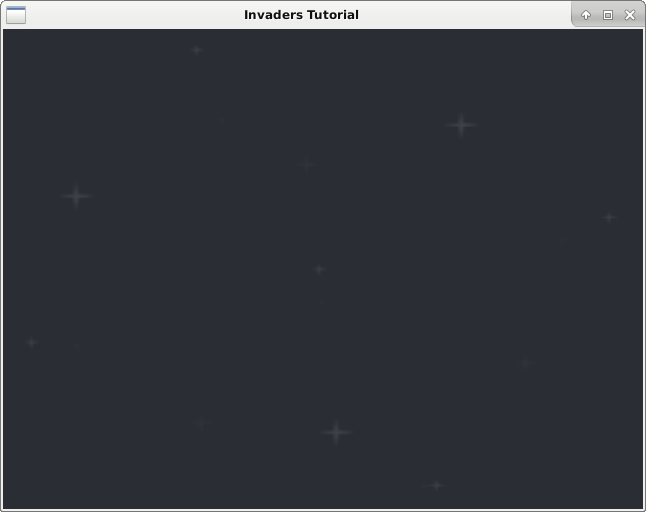Matrix Uniform
Gtk Invaders
Published
Liked the article? Share it!

In the next step we will add the player sprite, so we take a step to set an mvp matrix.
main.c
#include <epoxy/gl.h>
#include <epoxy/glx.h>
#include <gtk/gtk.h>
#include "DashGL/dashgl.h"
static void on_realize(GtkGLArea *area);
static void on_render(GtkGLArea *area, GdkGLContext *context);
#define WIDTH 640.0f
#define HEIGHT 480.0f
GLuint program;
GLuint vao;
GLint attribute_texcoord, attribute_coord2d;
GLint uniform_mytexture, uniform_mvp;
struct {
GLuint vbo;
GLuint tex;
mat4 mvp;
} background;
int main(int argc, char *argv[]) {
GtkWidget *window;
GtkWidget *glArea;
gtk_init(&argc, &argv);
// Initialize Window
window = gtk_window_new(GTK_WINDOW_TOPLEVEL);
gtk_window_set_title(GTK_WINDOW(window), "Invaders Tutorial");
gtk_window_set_position(GTK_WINDOW(window), GTK_WIN_POS_CENTER);
gtk_window_set_default_size(GTK_WINDOW(window), 640, 480);
gtk_window_set_type_hint(GTK_WINDOW(window), GDK_WINDOW_TYPE_HINT_UTILITY);
g_signal_connect(window, "destroy", G_CALLBACK(gtk_main_quit), NULL);
// Initialize GTK GL Area
glArea = gtk_gl_area_new();
gtk_widget_set_vexpand(glArea, TRUE);
gtk_widget_set_hexpand(glArea, TRUE);
g_signal_connect(glArea, "realize", G_CALLBACK(on_realize), NULL);
g_signal_connect(glArea, "render", G_CALLBACK(on_render), NULL);
gtk_container_add(GTK_CONTAINER(window), glArea);
// Show widgets
gtk_widget_show_all(window);
gtk_main();
return 0;
}
static void on_realize(GtkGLArea *area) {
// Debug Message
g_print("on realize 0
");
gtk_gl_area_make_current(area);
if(gtk_gl_area_get_error(area) != NULL) {
fprintf(stderr, "Unknown error
");
return;
}
const GLubyte *renderer = glGetString(GL_RENDER);
const GLubyte *version = glGetString(GL_VERSION);
g_print("Renderer: %s
", renderer);
g_print("OpenGL version supported %s
", version);
glClearColor(1.0f, 1.0f, 1.0f, 1.0f);
glGenVertexArrays(1, &vao);
glBindVertexArray(vao);
GLfloat background_vertices[] = {
0.0, 0.0, 0.0, 0.0,
0.0, HEIGHT, 0.0, 1.0,
WIDTH, HEIGHT, 1.0, 1.0,
0.0, 0.0, 0.0, 0.0,
WIDTH, HEIGHT, 1.0, 1.0,
WIDTH, 0.0, 1.0, 0.0
};
glGenBuffers(1, &background.vbo);
glBindBuffer(GL_ARRAY_BUFFER, background.vbo);
glBufferData(
GL_ARRAY_BUFFER,
sizeof(background_vertices),
background_vertices,
GL_STATIC_DRAW
);
mat4_identity(background.mvp);
background.tex = shader_load_texture("sprites/background.png");
GLint compile_ok = GL_FALSE;
GLint link_ok = GL_FALSE;
const char *vs = "shader/vertex.glsl";
const char *fs = "shader/fragment.glsl";
program = shader_load_program(vs, fs);
const char *attribute_name = "coord2d";
attribute_coord2d = glGetAttribLocation(program, attribute_name);
if(attribute_coord2d == -1) {
fprintf(stderr, "Could not bind attribute %s
", attribute_name);
return;
}
attribute_name = "uv_coord";
attribute_texcoord = glGetAttribLocation(program, attribute_name);
if(attribute_texcoord == -1) {
fprintf(stderr, "Could not bind attribute %s
", attribute_name);
return;
}
const char *uniform_name = "orthograph";
GLint uniform_ortho = glGetUniformLocation(program, uniform_name);
if(uniform_ortho == -1) {
fprintf(stderr, "Could not bind uniform %s
", uniform_name);
return;
}
uniform_name = "mvp";
uniform_mvp = glGetUniformLocation(program, uniform_name);
if(uniform_mvp == -1) {
fprintf(stderr, "Could not bind uniform %s
", uniform_name);
return;
}
uniform_name = "mytexture";
uniform_mytexture = glGetUniformLocation(program, uniform_name);
if(uniform_mytexture == -1) {
fprintf(stderr, "Could not bind uniform %s
", uniform_name);
return;
}
glUseProgram(program);
mat4 orthograph;
mat4_orthagonal(WIDTH, HEIGHT, orthograph);
glUniformMatrix4fv(uniform_ortho, 1, GL_FALSE, orthograph);
}
static void on_render(GtkGLArea *area, GdkGLContext *context) {
g_print("on render
");
glClear(GL_COLOR_BUFFER_BIT | GL_DEPTH_BUFFER_BIT);
glUseProgram(program);
glActiveTexture(GL_TEXTURE0);
glBindTexture(GL_TEXTURE_2D, background.tex);
glUniform1i(uniform_mytexture, 0);
glUniformMatrix4fv(uniform_mvp, 1, GL_FALSE, background.mvp);
glBindVertexArray(vao);
glEnableVertexAttribArray(attribute_coord2d);
glEnableVertexAttribArray(attribute_texcoord);
glBindBuffer(GL_ARRAY_BUFFER, background.vbo);
glVertexAttribPointer(
attribute_coord2d,
2,
GL_FLOAT,
GL_FALSE,
sizeof(float) * 4,
0
);
glVertexAttribPointer(
attribute_texcoord,
2,
GL_FLOAT,
GL_FALSE,
sizeof(float) * 4,
(void*)(sizeof(float) * 2)
);
glDrawArrays(GL_TRIANGLES, 0, 6);
glDisableVertexAttribArray(attribute_coord2d);
glDisableVertexAttribArray(attribute_texcoord);
}
Vertex Shader
Our updated vertex shader.
shader/vertex.glsl
#version 120
uniform mat4 orthograph;
uniform mat4 mvp;
attribute vec2 coord2d;
attribute vec2 uv_coord;
varying vec2 texcoord;
void main (void) {
gl_Position = orthograph * mvp * vec4(coord2d, 0.0, 1.0);
texcoord = uv_coord;
}
Compile
$ gcc -c -o DashGL/dashgl.o DashGL/dashgl.c -lepoxy -lpng -lm
$ gcc `pkg-config --cflags gtk+-3.0` main.c DashGL/dashgl.o `pkg-config --libs gtk+-3.0` \
-lepoxy -lm -lpngRun
$ ./a.out